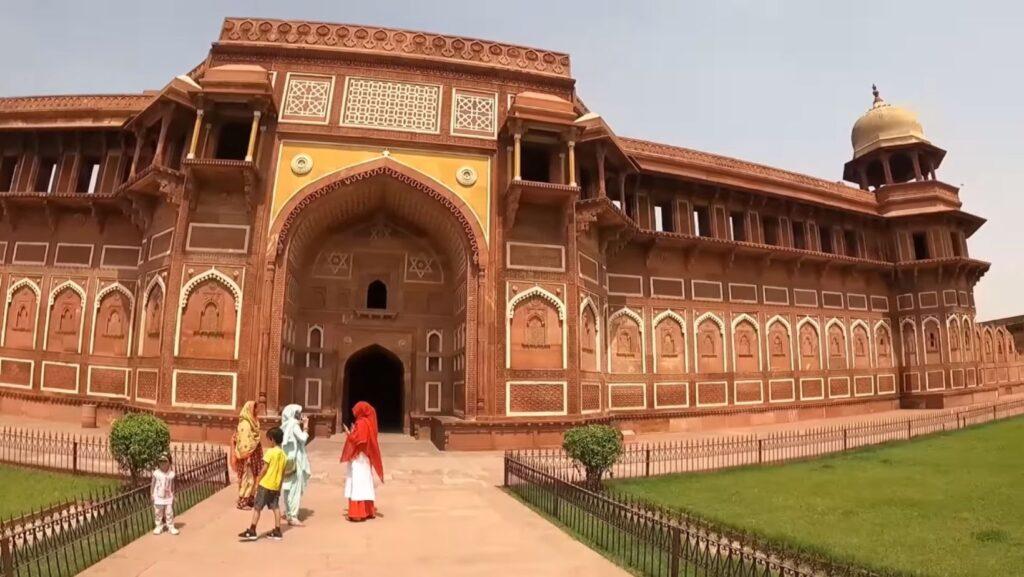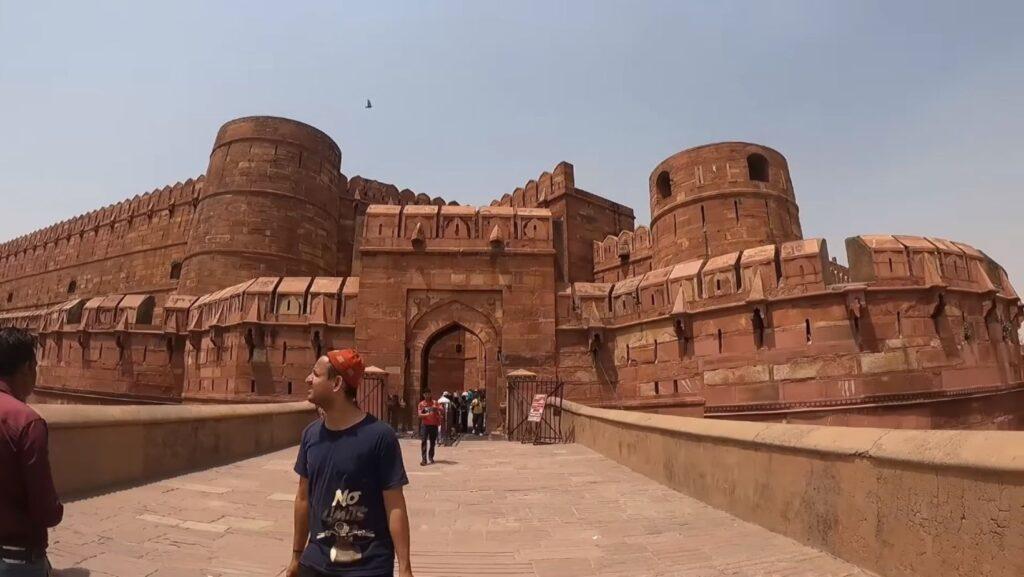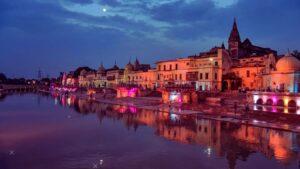If you are looking for places to visit near me in Agra, you should not miss the Agra Fort, one of the most impressive historical monuments in India.
The Agra Fort, also known as the Red Fort of Agra, is a UNESCO World Heritage Site and a symbol of the Mughal Empire’s power and glory.

It is located on the banks of the Yamuna River, about 2.5 km from the Taj Mahal, the world-famous mausoleum of love. Everything you need to know about the Agra Fort, from its history and architecture to its timings and ticket prices. We will also tell you how to reach the Agra Fort from the Taj Mahal and what to see and do there.
History of the Agra Fort
The history of the Agra Fort dates back to several centuries. It was originally a brick fort built by the Rajput rulers of Agra in the 11th century. It was captured by various invaders and rulers over time, including the Delhi Sultanate, the Lodhi dynasty, and the Mughal dynasty.
The most significant transformation of the fort took place under the reign of Akbar, the third Mughal emperor, who made Agra his capital in 1558. He demolished the old brick fort and rebuilt it with red sandstone from 1565 to 1573. He also added many palaces, halls, mosques, and gardens inside the fort.
The Agra Fort witnessed many important events in the history of the Mughal Empire, such as the coronation of Jahangir, the son of Akbar; the marriage of Shah Jahan and Mumtaz Mahal; and the imprisonment of Shah Jahan by his son Aurangzeb.
The fort also faced many attacks and sieges by various enemies, such as the Marathas, the Jats, and the British. The fort gradually lost its importance and glory after the decline of the Mughal Empire in the 18th century.
Architecture of the Agra Fort
The architecture of the Agra Fort is a masterpiece of Mughal art and engineering. The fort covers an area of about 94 acres and is surrounded by a 2.5 km long wall that is 21 meters high. The wall has four gates: the Delhi Gate, the Lahore Gate, the Khizri Gate, and the Amar Singh Gate. The Delhi Gate and the Lahore Gate are also known as the Akbari Gate and the Jahangiri Gate respectively. The Delhi Gate is the most grandiose and ornate gate of the fort, but it is closed to visitors.
The interior of the fort is divided into two sections: the inner citadel or palace area and the outer citadel or administrative area. The inner citadel contains many buildings that reflect different styles and periods of Mughal architecture. Some of them are:
- The Diwan-i-Aam or Hall of Public Audience: This is a large hall where Akbar used to hold his court and address his subjects. It has a red sandstone throne on a raised platform that faces a marble canopy where visitors used to stand.
- The Diwan-i-Khas or Hall of Private Audience: This is a smaller hall where Akbar used to meet his important guests and nobles. It has a white marble throne that is carved with floral patterns and precious stones.
- The Khas Mahal or Private Palace: This is a palace where Shah Jahan used to live with his wives and children. It has three pavilions: one for sleeping, one for dressing, and one for worship.
- The Sheesh Mahal or Mirror Palace: This is a palace that was used as a royal dressing room or bathhouse. It has walls and ceilings covered with mirrors that reflect light in different colors.
- The Musamman Burj or Octagonal Tower: This is a tower where Shah Jahan used to watch his beloved Taj Mahal from his bed during his last years in captivity. It has a marble balcony that offers a stunning view of the Taj Mahal.
- The Moti Masjid or Pearl Mosque: This is a mosque that was built by Shah Jahan for his personal use. It has a white marble dome and three domed chambers that are decorated with calligraphy and floral designs.
The outer citadel contains many buildings that were used for administrative and military purposes. Some of them are:
- The Jahangiri Mahal or Jahangir’s Palace: This is a palace that was built by Akbar for his son Jahangir. It is one of the oldest and largest buildings in the fort. It has a blend of Hindu and Islamic architectural features, such as domes, arches, pillars, and brackets.
- The Anguri Bagh or Grape Garden: This is a garden that was built by Shah Jahan in front of the Khas Mahal. It has four quarters that are separated by water channels and fountains. It was used for growing grapes and other fruits.
- The Nagina Masjid or Gem Mosque: This is a mosque that was built by Shah Jahan for his ladies. It has a white marble facade and three domed chambers that are adorned with gemstones.
- The Mina Masjid or Heavenly Mosque: This is a mosque that was built by Shah Jahan for his private use. It has a white marble structure and three small domes that are embellished with gold.
- The Machhi Bhawan or Fish Enclosure: This is a complex that was used for keeping fish and other aquatic animals.
Timings of the Agra Fort
The timings of the Agra Fort are from 6:00 a.m. to 6:00 p.m. on all days except Friday when it is closed for general viewing. However, it is open for Muslims who want to pray at the mosque inside the complex on Fridays.
Ticket Price of the Agra Fort
The ticket price of the Agra Fort varies depending on your nationality and age.
- Foreign tourist: 650 rupees
- Citizens of SAARC and BIMSTEC countries: 90 rupees
- Domestic/Indian/OCI cardholder: 50 rupees
- Children below 15 years (both domestic and foreign): Free
You can buy tickets for the Agra Fort online through the official website of the Archaeological Survey of India or, which offer information and ticketing service for the Taj Mahal and other monuments.
Agra Fort to Taj Mahal Distance
The distance from Agra Fort to the Taj Mahal is only 2.5 km, which can be covered easily in 15 minutes by car, rickshaw, or bicycle. You can also walk along the Yamuna River bank to enjoy the scenic view of both monuments. There are many hotels, restaurants, shops, and other facilities available near both monuments to cater to your needs.
What to See and Do at the Agra Fort
There are many things to see and do at the Agra Fort that will make your visit worthwhile. Here are some of them:
- Explore the various buildings and structures inside the fort and admire their architectural beauty and historical significance.
- Learn about the history and culture of the Mughal Empire and its rulers through the exhibits, paintings, and inscriptions displayed in the fort.
- Enjoy the view of the Taj Mahal from the Musamman Burj or Octagonal Tower, where Shah Jahan used to spend his last days.
- Watch the light and sound show that narrates the story of the fort and its inhabitants in an entertaining way. The show is held every evening in Hindi and English languages.
- Shop for souvenirs, handicrafts, jewelry, carpets, leather goods, etc. at the nearby markets and bazaars.
- Taste the local cuisine, especially the Mughlai dishes, at the nearby restaurants and eateries.
The Agra Fort is a place that will fascinate you with its history, architecture, and culture. It is a place that will transport you to a different era of grandeur and glory. It is a place that will make you appreciate the legacy and heritage of India.
If you are looking for places to visit near me in Agra, you should not miss the opportunity to see the Agra Fort for yourself. It will be an unforgettable experience that will make your trip memorable.







